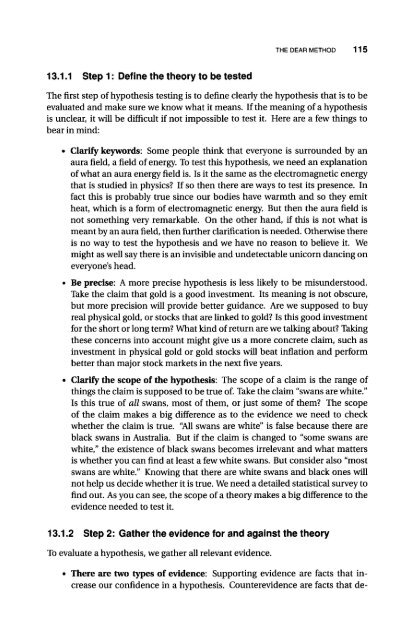An Introduction to Critical Thinking and Creativity - always yours
An Introduction to Critical Thinking and Creativity - always yours
An Introduction to Critical Thinking and Creativity - always yours
You also want an ePaper? Increase the reach of your titles
YUMPU automatically turns print PDFs into web optimized ePapers that Google loves.
THE DEAR METHOD 115<br />
13.1.1 Step 1 : Define the theory <strong>to</strong> be tested<br />
The first step of hypothesis testing is <strong>to</strong> define clearly the hypothesis that is <strong>to</strong> be<br />
evaluated <strong>and</strong> make sure we know what it means. If the meaning of a hypothesis<br />
is unclear, it will be difficult if not impossible <strong>to</strong> test it. Here are a few things <strong>to</strong><br />
bear in mind:<br />
• Clarify keywords: Some people think that everyone is surrounded by an<br />
aura field, a field of energy. To test this hypothesis, we need an explanation<br />
of what an aura energy field is. Is it the same as the electromagnetic energy<br />
that is studied in physics? If so then there are ways <strong>to</strong> test its presence. In<br />
fact this is probably true since our bodies have warmth <strong>and</strong> so they emit<br />
heat, which is a form of electromagnetic energy. But then the aura field is<br />
not something very remarkable. On the other h<strong>and</strong>, if this is not what is<br />
meant by an aura field, then further clarification is needed. Otherwise there<br />
is no way <strong>to</strong> test the hypothesis <strong>and</strong> we have no reason <strong>to</strong> believe it. We<br />
might as well say there is an invisible <strong>and</strong> undetectable unicorn dancing on<br />
everyone's head.<br />
• Be precise: A more precise hypothesis is less likely <strong>to</strong> be misunders<strong>to</strong>od.<br />
Take the claim that gold is a good investment. Its meaning is not obscure,<br />
but more precision will provide better guidance. Are we supposed <strong>to</strong> buy<br />
real physical gold, or s<strong>to</strong>cks that are linked <strong>to</strong> gold? Is this good investment<br />
for the short or long term? What kind of return are we talking about? Taking<br />
these concerns in<strong>to</strong> account might give us a more concrete claim, such as<br />
investment in physical gold or gold s<strong>to</strong>cks will beat inflation <strong>and</strong> perform<br />
better than major s<strong>to</strong>ck markets in the next five years.<br />
• Clarify the scope of the hypothesis: The scope of a claim is the range of<br />
things the claim is supposed <strong>to</strong> be true of. Take the claim "swans are white."<br />
Is this true of all swans, most of them, or just some of them? The scope<br />
of the claim makes a big difference as <strong>to</strong> the evidence we need <strong>to</strong> check<br />
whether the claim is true. "All swans are white" is false because there are<br />
black swans in Australia. But if the claim is changed <strong>to</strong> "some swans are<br />
white," the existence of black swans becomes irrelevant <strong>and</strong> what matters<br />
is whether you can find at least a few white swans. But consider also "most<br />
swans are white." Knowing that there are white swans <strong>and</strong> black ones will<br />
not help us decide whether it is true. We need a detailed statistical survey <strong>to</strong><br />
find out. As you can see, the scope of a theory makes a big difference <strong>to</strong> the<br />
evidence needed <strong>to</strong> test it.<br />
13.1.2 Step 2: Gather the evidence for <strong>and</strong> against the theory<br />
To evaluate a hypothesis, we gather all relevant evidence.<br />
• There are two types of evidence: Supporting evidence are facts that increase<br />
our confidence in a hypothesis. Counterevidence are facts that de-
















